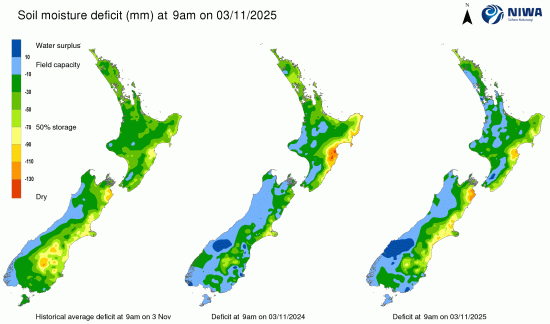Here's our summary of key economic events overnight that affect New Zealand, with news we have unexpectedly weak data from China and unexpectedly strong data from Australia.
But first in the US, it is back to work for their Federal government after the record 43 day shutdown impasse ends - at least until January 30 when the current deal needs renewal again. Missed official data releases there may in fact be skipped, so there may not be a catch-up until the next scheduled releases.
Meanwhile, American companies continue with their big job cuts.
Across the Pacific in China, their new yuan loan levels for October came in unexpectedly weak. They dropped sharply to just ¥220 bln, down from ¥1.3 tln in September and ¥500 bln in October last year. Markets had expected ¥500 bln, so the actual data underscores the continued weakness in credit demand. To put it in perspective, apart from July's unusual dip, this October result is their weakest of any month in at least ten years.
After a disappointing retreat in August, EU industrial production bounced back far less in September than expected. It is now only +1.2% higher (real) than a year ago, less than the expected +2.1% rise most analysts had anticipated. They will be disappointed, but for them at least it is still growing in real terms.
In Australia, they delivered another very strong set of employment data with jobs expanding by +42,200 and full time jobs expanding by +55,300. Their jobless rate fell more than expected to 4.2% (NZ is 5.3%.) This, along with inflation above target, will have the RBA thinking hard about their December 9 cash rate target which is currently 3.6%. Aussie bond yields spiked higher on the news, taking the NZGB yields up with them.
Australian consumer inflation expectations slipped slightly to 4.5% in November from 4.8% in October, the lowest reading since August. Actual CPI inflation in September came in at 3.5%.
Also in Australia, the opposition Liberal Party has dumped its commitment to net zero policies, a capitulation that will likely isolate it further from the electorate (but not Sky News After Dark commentators). It will now really struggle to hold its big city electorates from spirited challenges by teal candidates. In an odd 'compromise' they committed to staying in the Paris Agreement, but without Net Zero that is just greenwashing which will fool no-one. We are probably witnessing the demise of a political party that once was their 'natural' governing political force. Australia will now need a proper liberal opposition to Labor, maybe one born out of the teals.
Just as the Aussie Liberals were making that Trumpish decision, the IEA released its 2025 World Energy Outlook. It concluded that technology has moved so far so fast that "options to reduce emissions substantially are well understood and, in many cases, cost effective." From here, staying with fossil fuels will come with cost penalties.
Globally, freight rates for containerised cargoes dipped -5% this past week mainly on China-US rates, although China-EU rates rose marginally. Overall that makes them -46% lower than year-ago levels. Bulk freight rates are little-changed this week, to be +25% higher than year-ago levels.
The UST 10yr yield is now at 4.10%, up +4 bps from yesterday at this time. The key 2-10 yield curve is still at +50 bps. Their 1-5 curve is still +1 bp positive and the 3 mth-10yr curve is now +14 bps positive. The China 10 year bond rate is up +1 bp at 1.81%. The Australian 10 year bond yield starts today at 4.44%, up +7 bps from yesterday on the implications of the labour market data. The NZ Government 10 year bond rate starts today up at just on 4.20%, up +6 bps and push there by the Aussie effect.
Wall Street's mood has soured today, now down -1.3% in their Thursday trade. European markets were up down too, between Paris's -0.1% and Frankfurt's -1.4%. Tokyo ended yesterday up another +0.4%. Hong Kong was up +0.6% and Shanghai by +0.7%. Singapore rose another +0.2%. The ASX200 ended its Thursday session down -0.5%, while the NZX50 matched that. To be fair however, most of today's pullbacks are from near record highs. And on Wall Street, more than 80% of companies in the S&P500 reported earnings better than analysts' estimates.
The price of gold will start today at US$4198/oz, up another +US$8 from this time yesterday. It is rising again but it is still below its record US$4350 on October 21, 2025. Silver is moving up too, now at US$53/oz but again still lower than its recent peak of US$54.50 on October 17, 2025.
American oil prices have recovered +50 USc from yesterday to be just on US$59/bbl, with the international Brent price now over US$63/bbl.
The Kiwi dollar is now at just on 56.7 USc, and up +10 bps from yesterday. Against the Aussie we have held at 86.6 AUc. Against the euro we are down -10 bps at 48.7 euro cents. That all means our TWI-5 starts today at just under 61.2 and little-changed from yesterday.
The bitcoin price starts today at US$101,032 and down another -0.6% from yesterday. Volatility over the past 24 hours has been modest at just on +/- 1.5%.
Daily exchange rates
Select chart tabs
The easiest place to stay up with event risk is by following our Economic Calendar here ».
2 Comments
Frozen iguanas in Florida was not on my runaway global warming bingo chart.
https://www.wptv.com/weather/weather-news/watch-cold-snap-freezes-iguan…
Some will claim it is evidence that global warming is not happening, proving their lack of understanding.
I just skimmed the article but the iguanas aren't dying are they? Just going into some form of stasis?


We welcome your comments below. If you are not already registered, please register to comment.
Remember we welcome robust, respectful and insightful debate. We don't welcome abusive or defamatory comments and will de-register those repeatedly making such comments. Our current comment policy is here.